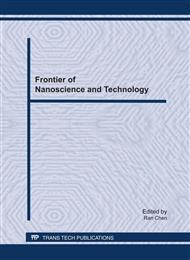[1]
X. F. Duan, Y. Huang, R. Agarwal, C. M. Lieber, Nature Vol. 421(2003), pp.241-243.
Google Scholar
[2]
J. C. Johnson, H. Q. Yan, R. D. Schaller, L. H. Haber, R. J. Saykally, P. D. Yang, J. Phys. Chem. B Vol. 105(2001), pp.211387-11389.
Google Scholar
[3]
Guang Zhu, Rusen Yang, Sihong Wang, and Zhong Lin Wang. Nano Lett Vol. 10(2010), pp.4177-4178.
Google Scholar
[4]
C. Ma, Y. Ding, X. D. Wang, Z. L. Wang, J. Am. Chem. Soc Vol. 126(2004), pp.708-710.
Google Scholar
[5]
D. Moore, C. Ronning, C. Ma, Z. L. Wang, Appl. Phys. Letts Vol. 385(2004), pp.8-10.
Google Scholar
[6]
J. P. Ge, Y. D. Li, Adv. Funct. Mater Vol. 14(2004), pp.2-4.
Google Scholar
[7]
C. S. Lao, P. X. Gao, R. S. Yang, Y. Dai, Z. L. Wang, Chem. Phys. Lett Vol. 417(2005), pp.359-363.
Google Scholar
[8]
Z. L. Wang. Mater. Sci. Eng. R Vol. 64(2009), pp.33-37.
Google Scholar
[9]
X. Y. Kong, Y. Ding, R. S. Yang, Z. L. Wang, Science Vol. 303(2004), pp.1348-1349.
Google Scholar
[10]
X. D. Wang, J. H. Song, Z. L. Wang, Chem. Phys. Lett Vol. 424(2006), pp.86-89.
Google Scholar
[11]
P. X. Gao, Y. Ding, W. Mai, W. L. Hughes, C. S. Lao, Z. L. Wang, Science Vol. 309(2005), pp.1700-1703.
Google Scholar
[12]
P. X. Gao, C. S. Lao, Y. Ding, Z. L. Wang, Adv. Funct. Mater Vol. 16(2006), pp.53-55.
Google Scholar
[13]
G. Y. Chen, T. Thundat, E. A. Wachter, R. A. Warmack, J. Appl. Phys Vol. 77(1995), pp.3618-3619.
Google Scholar
[14]
J. Fritz, M.K. Baller, H. P. Lang, H. Rothuizen, P. Vettiger, E. Meyer, H. J. Guntherodt, C. Gerber, J. K. Gimzewski, Science Vol. 288(2000), pp.316-318.
DOI: 10.1126/science.288.5464.316
Google Scholar
[15]
W. L. Hughes, Z. L. Wang, Appl. Phys. Lett Vol. 82(2003), pp.2886-2887.
Google Scholar
[16]
Yu dong Gu, Jun Zhou , Wenjie Mai , Ying Dai , Gang Bao , Zhong Lin Wang , Chem. Phys. Lett Vol. 484(2010), pp.96-99.
Google Scholar
[17]
Z. W. Pan, Z. R. Dai, Z. L. Wang, Science Vol. 291(2001), p.1947-(1949).
Google Scholar
[18]
H. Q. Yan, R. R. He, J. Johnson, M. Law, R. J. Saykally, P. D. Yang, J. Am. Chem. Soc Vol. 125(2003), pp.4728-4730.
Google Scholar
[19]
Z. L. Wang, X. Y. Kong, J. M. Zuo, Phys. Rev. Lett Vol. 91(2003), pp.185502-185503.
Google Scholar
[20]
H. W. Seo, S. Y. Bae, J. Park, Appl. Phys. Lett Vol. 82(2003), pp.3752-3754.
Google Scholar
[21]
J. M. Vohs, M. A. Barteau, Surf. Sci Vol. 221(1989), pp.590-593.
Google Scholar
[22]
M. H. Huang, Y. Y. Wu, H. N. Feick, N. Tran, E. Weber, P. D. Yang, Adv. Mater Vol. 13(2001), pp.13-16.
Google Scholar
[23]
K. Vanheusden, W. L. Warren, C. H. Seager, D. R. Tallant, J. A. Voigt, B. E. Grade, J. Appl. Phys Vol. 79(1996), pp.7983-7985.
Google Scholar


